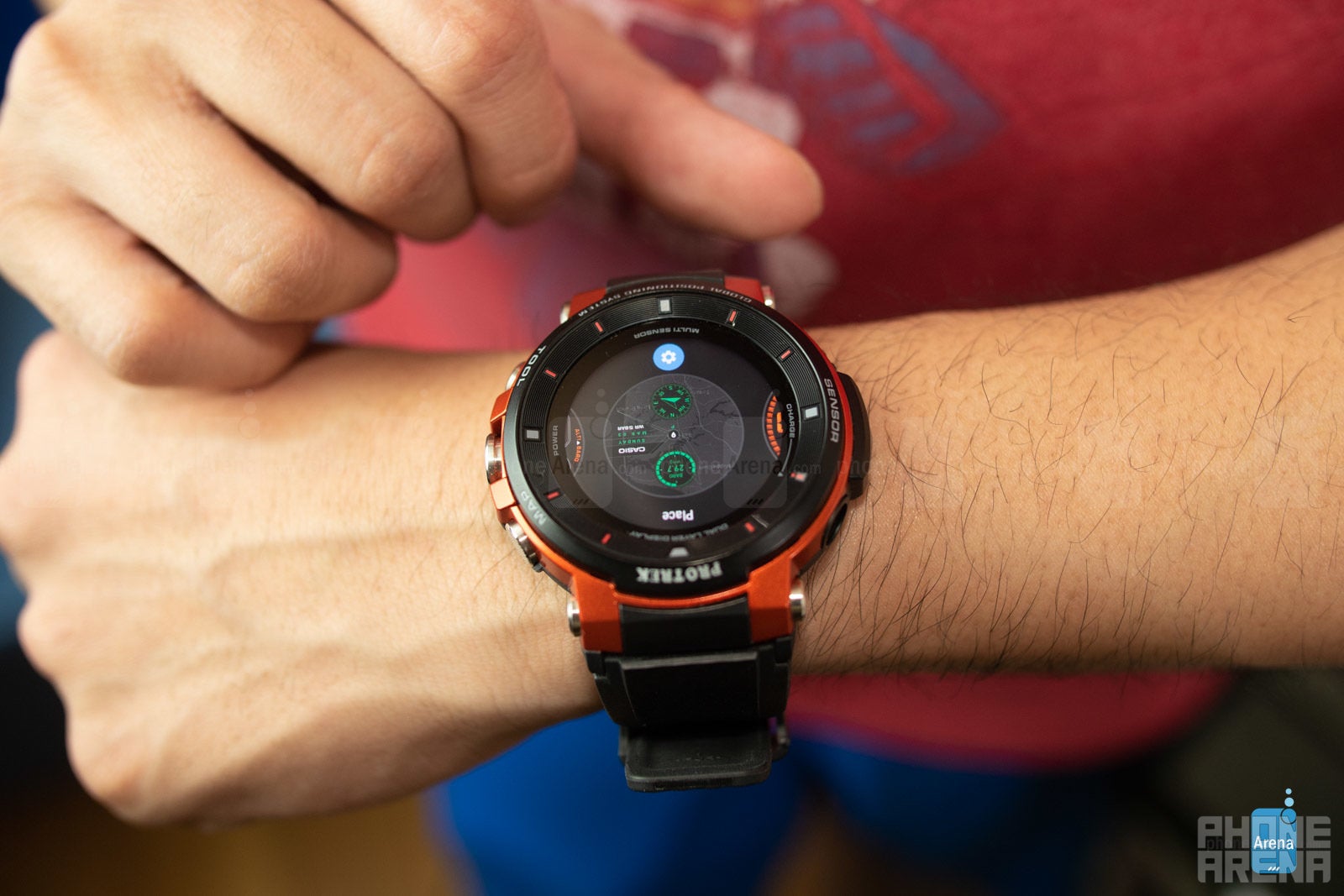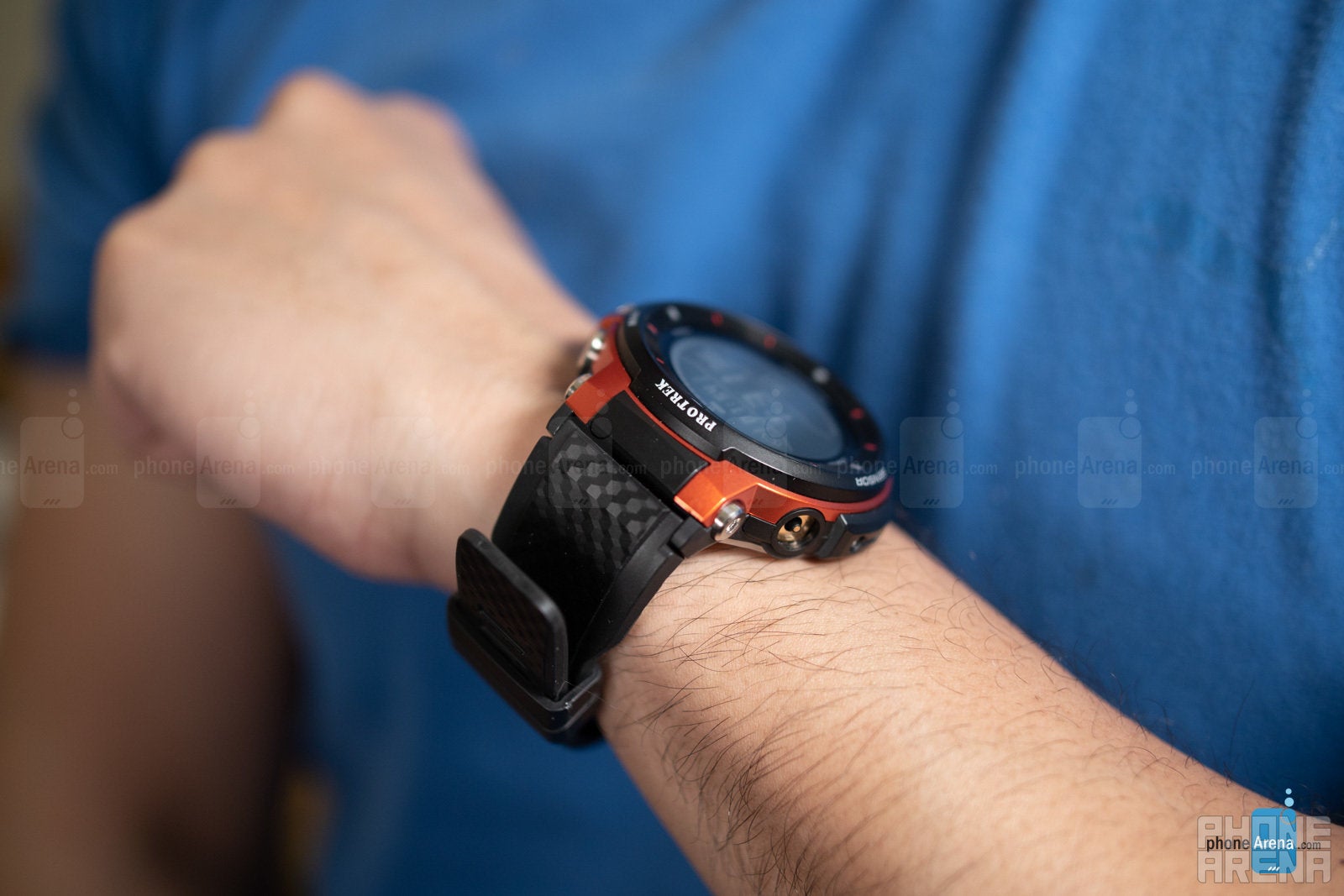Casio PRO TREK SMART WSD-F30 Review

Review index
Design and comfort | Display and Controls | Functionality, processor, performance | Activity tracking | Connectivity and multimedia | Battery life | ConclusionThe vast majority of Wear OS smartwatches follow a similar strategy. Most of them favor casual-looking designs that make them suitable to wear for different occasions. However, the Casio PRO TREK SMART WSD-F30 bucks the trend by favoring utility more than anything else. Casio’s PRO TREK line has a reputation to uphold, so it’ll be interesting to see how the WSD-F30 turns out!
In the box:
- Casio PRO TREK Smart WSD-F30
- Wall charger
- Proprietary charging cable
- Quick start guide and warranty information
Design and comfort

As for the case itself, it’s comprised from this resin material that’s been coated to give it that rugged look and feel. Our particular unit is accented with the color orange, making it quite a standout characteristic for a smartwatch – more so when the majority flaunt monotone or reserved colors. Still, this accent combined with the rugged design, large screws, and the carbon fiber pattern of the wrist strap, definitely gives off that vibe that this smartwatch is meant to withstand some serious punishment!
And you know what? That’s exactly one of its biggest assets! The WSD-F30's design meets MIL-STD-810G for protection from just about anything that life can throw at us, while also featuring 5-bar water resistance. That’s a significant step up over most smartwatches, just because it’ll survive submersion under water at up to 50 meters. Now, the drawback is that it doesn’t come with a heart rate sensor on its underside. We’re told that this omission was necessary to ensure that the WSD-F30 meets the MIL-STD-810G standards.
Display and Controls
A unique quality about the WSD-F30 is that it features a dual-layer display, which is comprised out of that OLED panel we just mentioned and a monochrome LCD on top of it. Typically, smartwatch screens don’t handle direct sunlight all that great, but the monochrome LCD layer on the WSD-F30 has excellent visibility. The white details on the black background showing the time, date, and battery level, definitely provide strong contrast, making it far superior to other displays. What it shows in the LCD monochrome layer can vary depending on what mode the watch is in – something we’ll discuss later in the software section.
When the main OLED display times out and the watch goes into standby, the monochrome LCD turns on automatically – only to switch back again to the OLED panel when we get back to interacting with the WSD-F30. There’s a way to leverage the OLED display solely by toggling on the “Always-on” setting in the display settings menu, so that the OLED panel is used in standby as opposed to the monochrome LCD one. And lastly, the display itself is recessed, so it doesn’t incur any scuffs or scratches if you lay it flat down.
Three physical buttons line the right side of the WSD-F30, all featuring textured surfaces to make them distinguishable. The top one accesses the map, the middle functions as the usual apps panel/back function with Wear OS, and the bottom one launches the tools portal where we can scroll through the compass, altimeter, barometer, sunrise/sunset times, and more. In the tools portal, we can long-press the tools button again to initiate the monochrome LCD display.
Functionality, processor, performance

Fitness junkies will want to look elsewhere, especially if they’re intent on accurately tracking workouts and the amount of calories burned. That’s partly because the watch doesn’t feature a heart rate sensor, so most of its fitness tracking is isolated to tracking the motion of the smartwatch through its sensors (accelerometer & gyroscope), on top of its tri-GPS system. Casio is marketing the WSD-F30 as a smartwatch for the outdoor enthusiast, or those that simply prefer outdoor activities – like hiking, skiing, and golfing, to name a few.
Casio has partnered with many third-party apps, like the golf app “Hole19” and the ski tracking app “Ski Tracks,” to take advantage of sensors in the WSD-F30 to provide users with detailed information. For example, we tested out the Ski Tracks app, which provided relevant data like our max speed, ski distance, altitude, and more. Beyond that, most of functions and features of Wear OS are intact here and are no different. Although, since it lacks an internal speaker, you can’t conduct phone calls on it.
You can also access “full-color offline maps” by simply pressing the dedicated maps button on the side of the watch, choose what area you want to download, and it’ll store it locally. Therefore, in the event you don’t have any connectivity, you can still access the map through the WSD-F30. It’s pretty crude in what it does, offering nothing more than pinpoints we can select on the map for directions, but hey, if you’re lost in the middle of nowhere and just need to get your bearings, it’s a handy thing to have in a pinch.
Another selling point for the WSD-F30 are the three different modes that the smartwatch can operate in. The first one is your typical “normal mode” that allows access to all of the smartwatch’s functions and sensors – giving it a rating of 1.5 days with its battery. Secondly, there’s “extended mode” that offers limited activity tracking, with Bluetooth and Wi-Fi disabled to help deliver a battery life of 3 days. And lastly, “Multi-Timepiece Mode” places it into a low-power mode that turns off everything and only displays the time and sensor data on the monochrome display. In this mode, however, it’s rated for upwards of a month with battery life!
Casio hasn’t disclosed what processor is powering the WSD-F30. Regardless of that, its performance is pretty responsive and fluid. Running apps are instantaneous, while scrolling through the menus is accompanied with tight responses.
Activity tracking
Employing a tri-GPS system, consisting of the United States GPS system, Russia’s GLONASS, and Japan’s Michibiki, the watch ensures precise accuracy with very little time required to pinpoint our location. For activities like running outdoors, the tri-GPS helps to track our location on a map throughout the run.
However, if you’re planning to use the WSD-F30 for other activities, such as burning calories during your biking session or Pilates class, then you may want to look elsewhere because the data it produces will simply be an approximation based on your movement, age, weight, and height. The watch simply won’t obtain the same accurate calorie burn data as those smartwatches with integrated heart rate monitors. Not surprisingly, Google Fit is preloaded, so that’s the portal for all-things activity tracking.
Connectivity and multimedia

When it comes to storage, there’s a limited amount to work with. From the looks of it, there’s roughly 2.15GB of total storage, but it turns out to be more like 1.5GB of available storage after all the apps have been updated. You’ll need to be extra mindful about what you store, seeing that it’s limited a bit more than other smartwatches in this area that tend to boast closer to 4GB.
Battery life
Impressively enough, the Casio PRO TREK SMART WSD-F30 is one of the better-performing Wear OS smartwatches we’ve encountered in a while when it comes to battery life. Even though battery capacity isn’t stated, we’re happy to report that endurance is better than average. Specifically, in our day-to-day experience, we’re able to get two full days of usage out of a full charge. By the start of the third day, its battery is typically at the 15% mark, which is still impressive. Now, to be fair, we didn’t use the GPS as much – resorting instead to daily functions such as checking notifications, using it for music playback controls, and the occasional workout session with Google Fit.
Of course, that range can be extended by switching to the other modes available on the watch. What’s particularly noteworthy is the “Multi-Timepiece Mode,” which effectively turns it into a standard digital watch for timekeeping. Supposedly it’s capable of lasting around one month in this mode. And that’s swell if you’re the kind of user that will be primarily using it as a standard outdoor watch more than anything else.
Unlike some of its contemporaries, the WSD-F30 doesn’t require a snap-on pad or cradle of some kind to charge. Instead, its proprietary charging port is located on its left side, which has a single pin connector jutting out ever so slightly. There’s a magnetic connection to keep it firmly intact while charging, but can easily be severed by pulling it slightly. Due to the proprietary port, it requires a special charging cable as well – so you’ll want to pay extra attention because you don’t want to lose it.
Conclusion

So why on earth would someone ever consider paying the premium for the WSD-F30? Quite simply, for the reputation of Casio being a premier watchmaker, but also for the precise tri-GPS, the better than average battery life, the dual-layer display for superior visibility, and the PRO TREK line’s rugged nature. Some would question whether all of those reasons validate the higher sticker price, but if you have the disposable income, or if you’re serious about outdoor activities/sports, then by all means the WSD-F30 fits the bill.
For us, we adore that it’s a very different smartwatch. If you’re tired of all the same casual-styled Wear OS smartwatches, then definitely consider the WSD-F30.









Things that are NOT allowed: